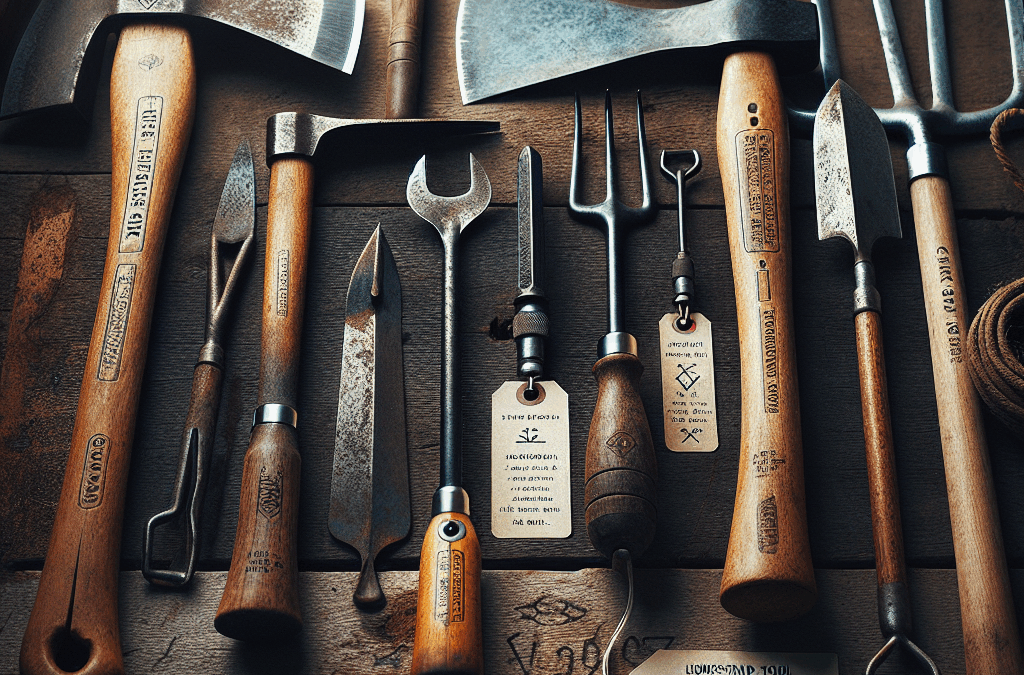Regular Cleaning and Maintenance
Why Cleaning is Essential
Think of your tools as your best friends on the homestead. They work hard for you, so they deserve a little TLC! Regular cleaning helps to prevent rust and other wear and tear that can sneak up on you over time. When I noticed my favorite shovel was getting rusty, I realized it was time to change my habits.
Using soapy water after every major use keeps the grime from building up. I’ve made it a habit to have a cleaning station set up next to my workspace. This removes the excuse of “not having time” to clean my tools. After a long day of gardening, a quick rinse can save so much hassle down the line.
And let’s be real, no one likes using a dirty tool! It’s just as much about enjoyment as it is about integrity. Having shiny, clean tools feels good and makes every task a bit more pleasant.
How to Maintain Tools
When it comes to tools, maintenance is key. After a good clean, I often check for any damage, like loose screws or chipped edges. Addressing these small issues immediately can prevent them from becoming major headaches later on. I always keep a small toolkit handy for on-the-spot fixes.
I recommend developing a routine schedule—maybe weekly or bi-weekly—to go through your tools methodically. This allows you to spot things that might otherwise go unnoticed. You might find that a tool hasn’t been used as much as you thought, or that it could use a few extra minutes of love.
Don’t underestimate the power of sharpening blades too! For my garden tools, a sharp edge makes all the difference in performance. I spend a few minutes before the gardening season sharpening my hoe, and it pays off big time when I get into planting.
Storing Tools Properly
Storage is just as important as cleaning and maintenance. One mistake I made early on was leaving tools out in the elements. Whether it’s rain or sun exposure, these conditions can seriously shorten the life of your tools. So now, I have designated storage spots for each one.
I built a simple tool rack in my shed, which keeps everything organized and off the ground. It’s also really nice to have a designated space for each tool, so I spend less time looking for them. Plus, it keeps them safe from any potential damage.
If you’re short on space, consider hanging tools on a garage wall or using magnetic strips for smaller items. Creative storage solutions can really help your tools stay in top condition and make your workflow smoother.
Using the Right Tools for the Job
Choosing Wisely
It’s so important to use the right tool for the task at hand. I learned this the hard way when I tried to use a wrench instead of a socket set and ended up stripping bolt heads. Now, I always ask myself if I have the correct tool before diving into a project.
A great way to ensure you’re prepared is to take inventory of your tools occasionally. Make sure you have what you need for upcoming projects, especially at the start of a new season. This way, you can avoid the frustration of having to make an unexpected trip to the hardware store.
Also, don’t underestimate how a simple tool can revolutionize your entire process. Sometimes, it’s the small things—a good pair of pruning shears, or a reliable hammer—that can make or break a project. Investing in high-quality tools in the long run will save you a lot of grief.
Safety First
Using tools safely isn’t just about following the rules. It’s about being smart and protecting yourself. I’ve had my fair share of close calls and learned that distractions can be dangerous. I try to ensure my work area is clear before I start.
Also, wear the appropriate safety gear. I make sure I have gloves, goggles, and proper footwear on hand every time I work. It might feel over the top, but it’s better to be safe than sorry!
Taking the time to clean up spills or debris not only improves your productivity but also keeps you safe. Avoiding accidents is a huge part of maintaining tool integrity. Remember, your well-being comes first.
Teaching Others
One of the best ways to ensure tool integrity is to teach others about proper use and maintenance. I love sharing my knowledge with friends and family, and it’s rewarding to see them take care of their tools.
When I hand over a tool to someone for the first time, I explain how to use it and why caring for it is important. We often end up talking about our experiences and sharing tips. Not only does this reinforce proper habits, but it also builds a sense of community around our projects.
Plus, teaching others also helps reinforce my own knowledge. It’s amazing how much I remember from explaining things to someone else—it reminds me to practice what I preach!
Regular Inspections
Making Inspections Routine
Just like I always check in with my plants, I take regular inspections for my tools seriously. Setting a specific time—maybe the first Saturday of every month—helps me stay on track. During these inspections, I thoroughly check for signs of wear and tear.
It might seem tedious, especially after a long week, but I promise, a few minutes can save you from future headaches. I remember a time when I found a crack in my wheelbarrow during an inspection, and I was grateful I caught it before it broke during use!
Sometimes, it helps to write down what you inspect in a journal. It’s a great way to track what needs attention and what has been maintained well over time. It’s nice to see progress and keep everything organized.
Understanding Lifespans
Every tool has its own lifespan, and knowing this can be vital in maintaining integrity. I’ve learned to look up guides on tools to understand how long they typically last and when I should replace them. This knowledge helps me avoid holding onto tools past their prime.
Some tools might hold sentimental value, but functionality must come first. I’ll keep an old hammer for memories but I know when to invest in a new one for actual use. Balancing sentiment with practicality is key.
Plus, older tools can sometimes require more maintenance, so factoring these things into your routine will help keep everything in check. It’s all about knowing the best time to say goodbye and when to make that investment.
Keeping a Repair Kit Handy
Last but not least, having a repair kit on hand is an absolute game-changer. It doesn’t have to be fancy—just some basic supplies like duct tape, a small wrench set, and even some glue can do the trick. I keep my kit in my shed, right next to where I store my tools.
Whenever I notice a tool needs some fixing, I’ll grab my kit right away instead of just putting it off. That way, I can keep everything in top shape without too much hassle. I’ve even gotten good at making quick fixes myself, which can be really satisfying.
Over time, I’ve collected little tips and tricks on minor repairs that I genuinely like sharing with others. There’s a real feeling of accomplishment when you can fix something by yourself. Plus, it directly contributes to maintaining integrity!
Investing in Quality Tools
High-Quality Materials Matter
When I first started homesteading, I went for the cheapest tools, and it backfired. I learned that investing upfront in quality materials pays off in durability and performance. Sure, it can be tempting to nip and tuck costs, but looking through my well-used tools, I appreciate the ones that still hold up after years of use.
Take the time to research tools before buying them. I often read reviews and might even test a tool at the store before making a purchase. Checking for warranties can also save you money in the long run. If something does happen, you’ll want to know you’re covered.
Also, remember that quality doesn’t just mean brands. Sometimes, locally made tools trump big names. Supporting local craftsmanship not only helps your community, but those tools often have that extra care put into them.
Longevity Over Price
The lifespan of a tool is something I consider carefully now. It’s often better to buy one high-quality tool that can serve for years than multiple cheaper alternatives that break easily. I always ask myself if it’s a long-term investment when I’m shopping.
Just because something seems like a steal at the moment doesn’t mean it’ll be worth it in the end. I’ve had tools in my shed that started breaking after just a few months—definitely not worth the hassle! It’s better to do your research and save up for that sturdy tool that’ll stand the test of time.
When I finally invested in a quality axe, it changed my perspective. Not only did it perform better, but it also reduces the risk of injury due to poor mechanics, as it cuts more smoothly.
Resale Value Considerations
It’s important to remember that good quality tools often have a higher resale value. If you’re like me, you might occasionally find yourself needing to declutter or upgrade. When I sold some of my better-maintained tools, I was surprised at how much someone would pay for them just because they were in good condition.
Keeping tools in good shape can also enhance their resale value, which can help fund your next purchase. I learned to keep my original packaging and manuals, as they can significantly boost a tool’s perceived value for a potential buyer.
Sometimes, I even share my tools with friends or neighbors, knowing that I’ll get them back in good shape when they’re done. It builds good relations and reinforces the importance of maintaining them on both ends. Just another way to invest wisely!
Conclusion
By applying these techniques for maintaining homestead tool integrity, I’ve not only saved a good bit of money but also fostered a greater appreciation for the tools I use day-in and day-out. It’s all about building a routine and proactively caring for these essential parts of homesteading life.
Remember, it’s not just about the tools themselves; it’s about the experience and memories you create while using them. Each time I reach for a well-maintained tool, it feels rewarding and it gets the job done right every time.
FAQs
1. Why is it important to clean my tools regularly?
Regular cleaning prevents rust and keeps your tools in good shape. It’s a simple step that enhances their longevity and performance.
2. What tools should I invest in for long-term use?
It’s best to invest in high-quality tools that suit your specific needs, like shovels, pruners, or quality saws. Focus on durability over price.
3. How can I ensure I’m using the right tool for the job?
Read up on the tools you own and assess each task beforehand to make sure you’re equipped with the right tool for efficiency and safety.
4. When is the best time to inspect my tools?
Setting a monthly routine for tool inspections can help you stay on top of any wear and tear and make any necessary repairs before using them heavily.
5. How can teaching others about tool maintenance help me?
Sharing your knowledge reinforces your own practices and builds a sense of community. It’s rewarding and encourages a culture of care for tools.





